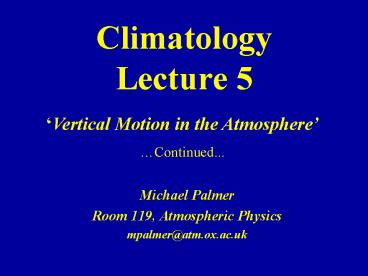Climatology Lecture 5 - PowerPoint PPT Presentation
1 / 53
Title:
Climatology Lecture 5
Description:
Pollution dispersion climatology. Potential Instability ... Pollution dispersion climatology. Absolute Stability. Absolute Stability. Absolute Stability ... – PowerPoint PPT presentation
Number of Views:68
Avg rating:3.0/5.0
Title: Climatology Lecture 5
1
ClimatologyLecture 5
Vertical Motion in the Atmosphere Continued...
- Michael Palmer
- Room 119, Atmospheric Physics
- mpalmer_at_atm.ox.ac.uk
2
Dry Example Absolute Stability Surface Temp 34
oC
Stable Air No convection No Rain
Environ Temp
Parcel Temp
Temperature
3
Dry Example Absolute Stability Surface Temp 34
oC
Stable Air No convection No Rain
Environ Temp
Parcel Temp
Temperature
4
Moist Example Absolute Instability Surface Temp
34 oC
Unstable Air Convection Rain
Condensation Level
Parcel Temp
Temperature
Environ Temp
5
Wet Example Conditional Instability
Unstable Air Convection Rain
Level of free convection
Condensation Level
Temperature
6
Vertical Motion
- Potential Instability
- Absolute Stability Topographically forced stable
cloud Pollution dispersion climatology
7
Potential Instability
- Conditional instability involves convective
ascent of parcels of air - Potential instability involves large scale ascent
of layers of air - Instability is potential since the air is stable
until lifted by an appropriate amount - Potential Instability may occur if a layer of air
is very moist at the bottom but very dry aloft
8
Stability depends on ELR
Temperature
Environ Temp
Parcel Temp
9
Stability depends on ELR
Temperature
Environ Temp
Parcel Temp
10
Z
Temperature
11
B
New ELR
A
Z
B
Old ELR
A
Temperature
12
Z
B
A
Temperature
13
A
Z
A
Temperature
14
B
A
Z
B
A
Temperature
15
B
Z
A
B
A
Temperature
16
B
More unstable
A
Z
B
Stable
A
Temperature
17
Potential Instability
- The initial lapse rate in the layer AB is stable
- On lifting of the entire layer, the base reaches
condensation quickly, since it is moist - the
slower rate of cooling (SALR) is applicable - but
the top of the layer cools at the DALR - The new layer AB is unstable for rising parcels.
18
Vertical Motion
- Potential Instability
- Absolute Stability Topographically forced stable
cloud Pollution dispersion climatology
19
Absolute Stability
??
20
Absolute Stability
21
Absolute Stability
22
Environmental lapse rate
Z
Dry adiabatic lapse rate
Temperature
23
Environmental lapse rate
1
Z
Dry adiabatic lapse rate
Temperature
24
Environmental lapse rate
1
Z
Dry adiabatic lapse rate
2
Temperature
25
Environmental lapse rate
1
3
Z
Dry adiabatic lapse rate
2
Temperature
26
Environmental lapse rate
1
3
4
Z
Dry adiabatic lapse rate
2
Temperature
27
Environmental lapse rate
1
3
5
4
Z
Dry adiabatic lapse rate
2
Temperature
28
Absolute Stability
1
3
4
2
29
Absolute Stability
30
Absolute Stability
Air hotter and drier on leeward side
31
(No Transcript)
32
(No Transcript)
33
(No Transcript)
34
(No Transcript)
35
H E I G H T
TEMPERATURE
36
H E I G H T
Subsidence Inversion
TEMPERATURE
37
H E I G H T
Subsidence Inversion
Surface Radiation Inversion
TEMPERATURE
38
H E I G H T
Early Morning
TEMPERATURE
39
H E I G H T
Daytime
Early Morning
TEMPERATURE
40
(No Transcript)
41
(No Transcript)
42
(No Transcript)
43
(Unstable)
(Near neutral stability)
G (dashed) DALR Solid - ELR
44
(No Transcript)
45
(No Transcript)
46
(No Transcript)
47
(No Transcript)
48
(No Transcript)
49
Stack Height
- Statistical characteristics of surface and
non-surface inversion layers depth, strength,
frequency - longer stacks increased eddy diffusion
- effective stack height H hs dh
- hs physical height of stack
- dh f (Stability, wind speed,stack exit
velocity, stack diameter, temperature of
emission, emission rate)
50
(No Transcript)
51
(No Transcript)
52
(No Transcript)
53
Readings for todays lecture
- Barry and Chorley 1997 p76-86
- Briggs et al. 1997 Fundamentals of the Physical
Environment p78-88 - Henderson-Sellers and Robinson 1999 p56-74
- Linacre and Geerts 1997 Climates and Weather
Explained p127-145 - McIlveen 1992 p109-139
- Oke, 1990 Boundary Layer Climates































